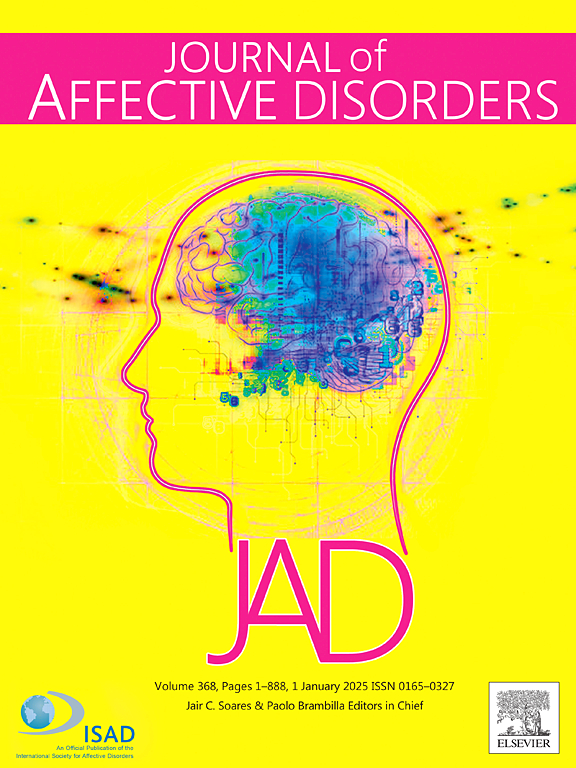Decomposing the association between caregiver burden and depressive symptoms in family caregivers of older adults: A network analysis
IF 4.9
2区 医学
Q1 CLINICAL NEUROLOGY
引用次数: 0
Abstract
Background
Caregiver burden is a well-established risk factor for depressive symptoms in family caregivers of older adults. However, previous research has predominantly relied on global sum scores, which may obscure specific patterns of association between distinct components of caregiver burden and depression. Network analysis offers a promising approach to reveal more granular insights by examining interactions between specific components of the constructs.
Method
This study employed an integrative data analysis approach, pooling baseline data of family caregivers of older adults from three randomized controlled trials (N = 681). A regularized Gaussian Graphical Model was estimated, incorporating 10 caregiver burden components (SCQ-AV) and 15 depressive symptoms (CES-D). Bridge node centrality and significant edges were examined to identify key components linking caregiver burden to depressive symptoms.
Results
The network analysis identified mood deterioration, social isolation, constant worrying, and health strain as key bridge nodes within the caregiver burden cluster. Notable associations of these bridge nodes with depressive symptoms included mood deterioration with depressed mood, social isolation with loneliness and anhedonia, constant worry with fearfulness, and health strain with fatigue.
Limitations
Cross-sectional design precludes inferences about directionality or causality.
Conclusion
The findings suggest several unique component-level pathways between caregiver burden and depressive symptoms. Conceptualizing caregiver burden and depression as a network of interacting components provides important insights beyond global sum scores.
分解照顾者负担与老年人家庭照顾者抑郁症状之间的关系:网络分析
背景:照顾者负担是老年人家庭照顾者抑郁症状的一个公认的危险因素。然而,先前的研究主要依赖于全球总和得分,这可能会模糊照顾者负担和抑郁的不同组成部分之间的特定关联模式。网络分析提供了一种很有前途的方法,通过检查结构的特定组件之间的相互作用来揭示更细粒度的见解。方法采用综合数据分析方法,汇集3项随机对照试验(N = 681)中老年人家庭照顾者的基线数据。估计一个正则化高斯图形模型,包含10个照顾者负担成分(SCQ-AV)和15个抑郁症状(CES-D)。桥节点中心性和显著边缘被检查以确定连接照顾者负担和抑郁症状的关键成分。结果网络分析发现情绪恶化、社会孤立、持续担忧和健康紧张是照顾者负担集群中的关键桥梁节点。这些桥结与抑郁症状的显著关联包括情绪恶化伴抑郁情绪,社交孤立伴孤独和快感缺乏,持续担忧伴恐惧,健康紧张伴疲劳。局限性横断面设计排除了对方向性或因果关系的推断。结论研究结果表明,照顾者负担与抑郁症状之间存在一些独特的成分水平通路。将照顾者负担和抑郁概念化为相互作用的组成部分的网络提供了超越全球总和得分的重要见解。
本文章由计算机程序翻译,如有差异,请以英文原文为准。
求助全文
约1分钟内获得全文
求助全文
来源期刊

Journal of affective disorders
医学-精神病学
CiteScore
10.90
自引率
6.10%
发文量
1319
审稿时长
9.3 weeks
期刊介绍:
The Journal of Affective Disorders publishes papers concerned with affective disorders in the widest sense: depression, mania, mood spectrum, emotions and personality, anxiety and stress. It is interdisciplinary and aims to bring together different approaches for a diverse readership. Top quality papers will be accepted dealing with any aspect of affective disorders, including neuroimaging, cognitive neurosciences, genetics, molecular biology, experimental and clinical neurosciences, pharmacology, neuroimmunoendocrinology, intervention and treatment trials.
 求助内容:
求助内容: 应助结果提醒方式:
应助结果提醒方式:


